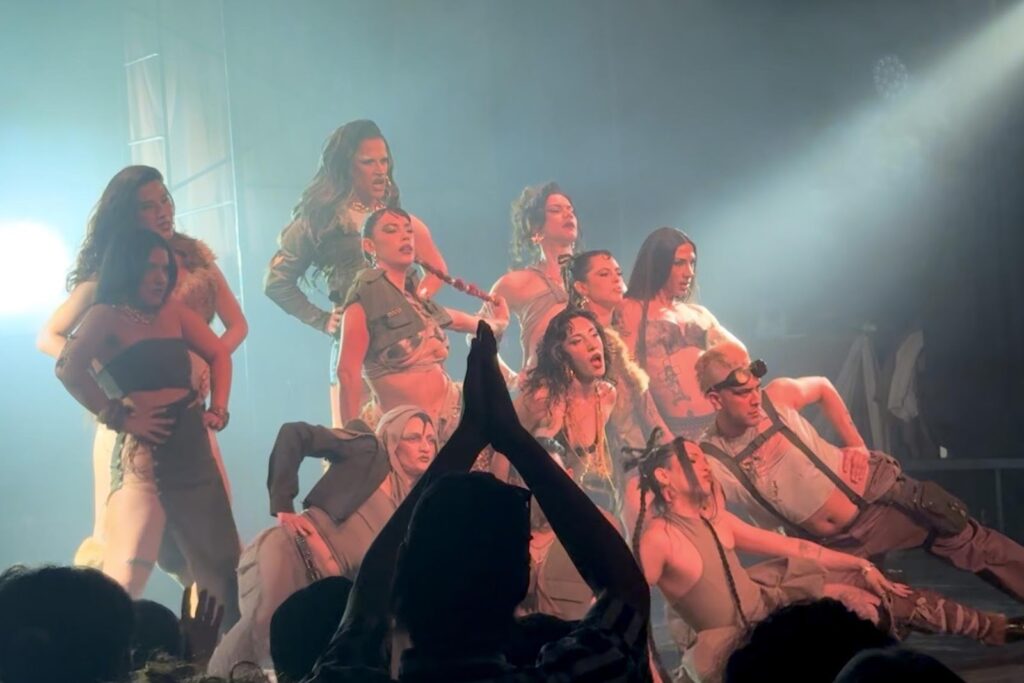By Ryan Wong ’27
On October 11th, I walked a little over five minutes from my apartment to Maquinal, an underground cultural center that frequently hosts drag shows, balls, and indie rock concerts, to attend the “Into the Mirage” ball hosted by the House of Raksha (formed in Buenos Aires in 2022). From the entrance, painted with multi-colored tiles as if the building were a giant disco ball, I stepped into a bar lit dimly by red lights, an electropop song playing in the background. Chatting around me and posing for the camera in a designated photoshoot area were performers and attendees who had dressed to the nines, their white cloaks, hoods, gold jewelry, and smoky makeup inspired by Egyptian pharaohs and the Dune series. Dressed in jeans and a blue top, I hid myself in a corner beside a group of men who had similarly ignored or lacked an outfit for the ball’s theme.

This ball and the house that organized it are part of an underground LGBTQI+ subculture pioneered by Black and Latino queer and transgender individuals between the 1960s and 1980s in New York City, known commonly as ballroom or ball culture. House ballroom, in which members of houses (groups of chosen families led by “mothers” and “fathers”) compete in various performance and appearance-based categories for awards and cash prizes, evolved from drag balls hosted in the mid-19th century. Black drag queens Crystal and Lottie LaBeija introduced the house system to ballroom culture, co-founding the first house (House of LaBeija) in 1968 and organizing the first all-Black ball in 1972 in response to the racism they experienced in the drag balls they attended.
Milei’s party unfortunately ended up winning the midterm elections. In spite of this result and the continued tirades against the LGBTQI+ community in Argentina, the country’s ballroom scene will continue to flourish and grow. In the City of Fury, a name given to Buenos Aires by the legendary Argentine rock band Soda Stereo, people of all identities will continue to strut, chant, and dance with anger, grief, joy, and hope, as they have since the beginning.

Alongside its competitive spirit, the ballroom was and continues to be an important space of refuge for trans and queer individuals, particularly Black and Latino trans and queer working-class youth. They were able to find family, love, and unconditional acceptance onstage and in their houses in an otherwise hostile world. With the globalization of the 21st century, the ballroom scene has migrated from New York and other cities across the U.S. to other countries such as Argentina, whose balls began in Buenos Aires around 2017 and have since grown while respecting the ballroom’s integrity as a site of community and resistance.
The “Into the Mirage” ball welcomed performers and attendees from across Argentina and neighboring Chile, and Brazil. Throughout the night, I was wowed not only by the costumes and attitudes of everyone on stage, but also by the constant calls for resistance. Following a stellar opening performance by the House of Raksha, the ball’s emcee began by asking the audience to vote in the midterm elections that would be held less than two weeks later on October 24th. A while later, during a segment of invited performers from other houses, a trans woman borrowed the microphone from the emcee to talk about the struggles that she and many of her friends currently face in Buenos Aires. Left unemployed by government spending cuts and unable to find other forms of work, she told us about how they have to resort to prostitution to afford food and basic necessities. “Hay que luchar,” she said to a chorus of applause, finger-snaps, and hands hitting the stage in assent. We must fight.

These statements occurred in the context of the far-right presidency of Javier Milei, who, during the World Economic Forum in Switzerland in January, equated “gender ideology” to “child abuse” and referred to LGBTQI+ people as “pedophiles”. Together with his attempts to prevent access to gender-affirming care for underage individuals and his dismantling of state bodies such as the Ministry of Women, Gender and Diversity and the National Institute Against Discrimination, Xenophobia and Racism, we understand the necessity of the ball I attended and others like it as spaces for the continued celebration of gender and sexual diversity in Argentina amidst federal attacks. Beneath the spotlight and before a screaming, starstruck crowd, individuals left in precarity by these attacks are not only able to assert their beauty and right to exist fearlessly, but to encourage others in the audience to resist for and alongside them.
Milei’s party unfortunately ended up winning the midterm elections. In spite of this result and the continued tirades against the LGBTQI+ community in Argentina, the country’s ballroom scene will continue to flourish and grow. In the City of Fury, a name given to Buenos Aires by the legendary Argentine rock band Soda Stereo, people of all identities will continue to strut, chant, and dance with anger, grief, joy, and hope, as they have since the beginning.


